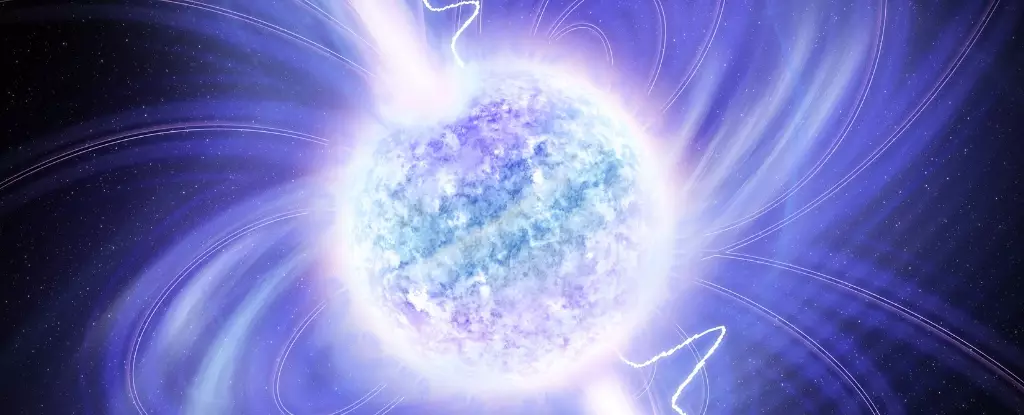The field of astrophysics has always been vibrant with the unexpected. Recently, a groundbreaking discovery has captured the attention of scientists and amateur astronomers alike: ASKAP J1839-0756, a unique celestial object that challenges our long-standing understanding of neutron stars. This discovery not only sheds light on the complexities of pulsars—those mesmerizing cosmic lighthouses emitting pulses of radio waves—but it deftly opens the door to new, unexplained phenomena that challenge the traditional rules of astrophysics.
Pulsars, typically spinning with incredible speed and performing a complete rotation in mere seconds, have fascinated observers since their first identification in the 1960s. Until now, these celestial high-speed beacons of energy were thought to have a specific upper limit on their spin rates, beyond which they’d cease to emit regular radio pulses. However, ASKAP J1839-0756 is poised to redefine these conventions with its incredibly sluggish rotation period of 6.5 hours, a feat that begs for deeper exploration.
The journey that led to the identification of ASKAP J1839-0756 was both serendipitous and systematic. Utilizing the capabilities of the Australian Square Kilometre Array Pathfinder (ASKAP) radio telescope, the CSIRO team made the fortuitous find during a routine observation in Western Australia. Upon analysis, the object exhibited a curious pattern with a luminosity drop of nearly 95% within a short span of fifteen minutes, piquing the researchers’ interest.
Initially mistaken for a mere transient event, further observations revealed its true nature: periodic radio emissions at an unprecedented interval. Collaborations with other telescopes, including the Australia Telescope Compact Array and South Africa’s MeerKAT, confirmed this remarkable periodicity—the first observations of their kind from an object spinning at such a leisurely pace.
Breaking the Rules of Astrophysics
What makes ASKAP J1839-0756 a particularly enthralling subject of study is the implications it brings to our understanding of neutron stars. Conventional wisdom states that as these compact celestial bodies lose rotational energy over time, their rotation slows, leading them toward dormancy in terms of radio emission. Thus, the existence of ASKAP J1839-0756—a pulsar emitting radio waves at intervals that stretch from hours to significantly longer periods—sets a precedent that forces researchers to grapple with astonishment and curiosity.
Most pulsars tend to act like a flashlight that reveals only one magnetic pole due to the close alignment of their rotational and magnetic axes. A mere three percent of these cosmic bodies allow researchers to observe both poles, classified as interpulses. ASKAP J1839-0756 stands apart as it not only spins slowly but also exhibits this uncommon behavior, hinting at its unique geometry and magnetic field.
The lack of models accommodating pulsars like ASKAP J1839-0756 reveals the limits of current astrophysical theory, pushing scientists to consider what additional physical conditions could permit its radio emissions.
As the astrophysical community digs delves deeper, they consider two main avenues to explain the pulsar’s peculiarity. One theory proposes that ASKAP J1839-0756 could be a magnetar—a type of neutron star scintillating under the influence of an immensely powerful magnetic field. Magnetars exhibit diverse mechanisms for radio emission, offering a potential explanation for maintaining their radio pulses despite slow spin rates. However, magnetars generally produce pulses within second-long periods, making ASKAP J1839-0756 an anomaly even among its kin.
On the other hand, the idea that ASKAP J1839-0756 could belong to a different class—namely, white dwarfs—has surfaced. Unlike neutron stars, white dwarfs have a slower rotation rate but have not been previously observed to pulse within the radio spectrum. However, without conclusive evidence for the presence of a white dwarf in this particular region, such theories remain unsubstantiated.
In unraveling the mysteries surrounding ASKAP J1839-0756, scientists are navigating uncharted territory in pulsar astrophysics. This discovery does more than challenge established norms; it signifies a turning point, urging experts to reassess the stratagem for understanding neutron stars and their behavior in the cosmos.
ASKAP J1839-0756 hands researchers an invaluable opportunity—to uncover the underlying physical mechanisms that may be at play, expanding the scope of what we deem possible. The universe, with its endless complexities, consistently challenges our imagination, reminding us of the vast unknown. As this investigation unfolds, scientists will undoubtedly uncover new secrets, pushing the boundaries of human knowledge. In this intricate tapestry of celestial wonders, ASKAP J1839-0756 emerges not just as a cosmic oddity, but as a beacon of inquiry in the cosmic sea.


Leave a Reply